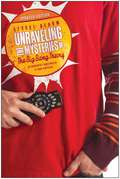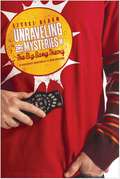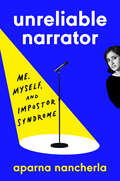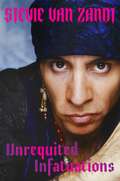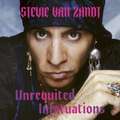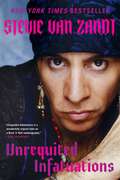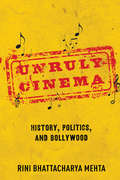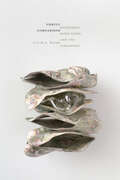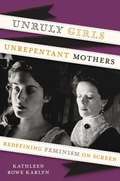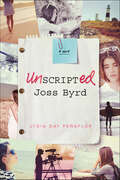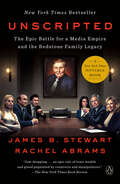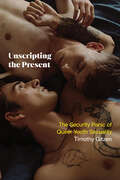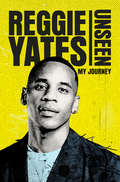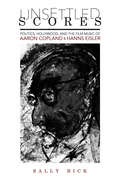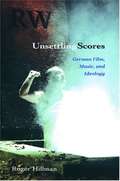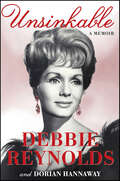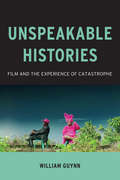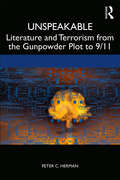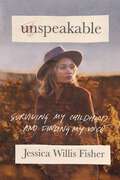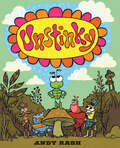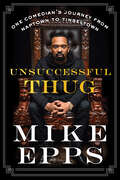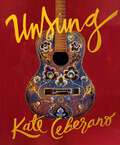- Table View
- List View
Unraveling the Mysteries of The Big Bang Theory (Updated Edition): An Unabashedly Unauthorized TV Show Companion
by George BeahmREVISED, UPDATED, AND EXPANDED! The Big Bang Theory – CBS's surprise hit sitcom – was recently renewed through 2017 after pulling in 19 million weekly viewers in its most recent season. Any fan who tunes in week to week wasn't surprised. The quirky show does what so few shows manage to do: straddle the fence between cult hit and mega-popular award-winner. Now, in Unraveling the Mysteries of The Big Bang Theory, longtime sf fan and author George Beahm has put together a guide with photographs for all fans of the show – mainstream tv viewers, sf and comics fans, and science enthusiasts alike. Whether you're a Penny or a Sheldon, whether you've just tuned in or been watching all along, this companion book will help you appreciate The Big Bang Theory to the fullest. Unraveling the Mysteries of The Big Bang Theory offers a full, comprehensive look at the series: from an analysis of the awful original pilot (that viewers may never get to see) to a tour of the real Cal Tech (which serves as one of the show's main settings), from a fandom terminology guide to enlightening analyses of the endearingly original main characters, all the show's quirkiest and most appealing elements are put under the microscope. This updated edition includes a focus on the show's female characters in addition to bringing the content up to date through the show's seventh season.
Unraveling the Mysteries of The Big Bang Theory: An Unabashedly Unauthorized TV Show Companion
by George Beahm4 Science Geeks + 1 Savvy Blonde Waitress = A Big Bang You don&’t have to be a theoretical physicist to understand why The Big Bang Theory is one of the most popular shows on television. Brains meet beauty in a calculus of comedy that always adds up to smart and hilarious results. Unraveling the Mysteries of The Big Bang Theory: An Unabashedly Unauthorized TV Show Companion is a quantum leap beyond the typical TV show guidebook. Exploring every nook and cranny of the Big Bang Theory universe, it provides a wealth of information about our favorite television show: A profile of &“intelligent designers&” Chuck Lorre and Bill Prady A detailed look at what went wrong with the unaired original pilot—and what went right in the reboot In-depth background on the principal actors and the characters they play A photo-illustrated breakdown of the Sheldonian universe, from couch to cosmos (including the show locations you can visit in real life) How to get your geek on, Big Bang—style A primer on the show&’s key scientific concepts, plus its galaxy of guest star scientists A concise guide to every episode and the meaning behind each title, organized by season An A-Z guide to the pop culture miscellanea mentioned in the show And more! Pull up a seat—just not Sheldon&’s, which is in a state of eternal dibs—and get ready to unravel the mysteries of The Big Bang Theory.
Unreliable Narrator: Me, Myself, and Impostor Syndrome
by Aparna Nancherla&“A deeply honest and funny look at how exhausting it can be to live a human life, Unreliable Narrator is a book for anyone who wants to laugh and feel less alone.&”—Amy Poehler A hilarious and insightful collection of essays exploring impostor syndrome, from the inside and out, by the most successful fraud in comedyAparna Nancherla is a superstar comedian on the rise—a darling of Netflix and Comedy Central&’s comedy special lineups, a headliner at comedy shows and music festivals, a frequenter of late night television and the subject of numerous profiles. She&’s also a successful actor who has written a barrage of thoughtful essays published by the likes of the New York Times. If you ask her, though, she&’s a total fraud. She&’d hate to admit it, but no one does impostor syndrome quite like Aparna Nancherla.UNRELIABLE NARRATOR is a collection of essays that uses Aparna&’s signature humor to illuminate an interior life, one constantly bossed around by her depression (whom she calls Brenda), laced with anxiety like a horror movie full of jump-scares, and plagued by an unrepenting love-hate relationship with her career as a painfully shy standup comedian. But luckily, crippling self-doubt comes with the gift of keen self-examination. These essays deliver hilarious and incredibly insightful meditations on body image, productivity culture, the ultra-meme-ability of mental health language, and who, exactly, gets to make art &“about nothing.&” Despite her own arguments to the contrary, UNRELIABLE NARRATOR is undeniable proof that Aparna is a force—as a comedian and author alike—to be reckoned with.
Unrequited Infatuations: A Memoir
by Stevie Van Zandt'A wonderfully original take on a Rock and Roll autobiography' Paul McCartney'An inimitable Rock 'n' Roll life told as boldly as it was lived' Bruce SpringsteenWhat story begins in a bedroom in suburban New Jersey in the early '60s, unfolds on some of the country's largest stages, and then ranges across the globe, demonstrating over and over again how Rock and Roll has the power to change the world for the better? This story.The first true heartbeat of UNREQUITED INFATUATIONS is the moment when Stevie Van Zandt trades in his devotion to the Baptist religion for an obsession with Rock and Roll. Groups like the Beatles and the Rolling Stones created new ideas of community, creative risk, and principled rebellion. They changed him forever. While still a teenager, he met Bruce Springsteen, a like-minded outcast/true believer who became one of his most important friends and bandmates. As Miami Steve, Van Zandt anchored the E Street Band as they conquered the Rock and Roll world.And then, in the early '80s, Van Zandt stepped away from E Street to embark on his own odyssey. He refashioned himself as Little Steven, a political songwriter and performer, fell in love with Maureen Santoro who greatly expanded his artistic palette, and visited the world's hot spots as an artist/journalist to not just better understand them, but to help change them. Most famously, he masterminded the recording of "Sun City," an anti-apartheid anthem that sped the demise of South Africa's institutionalized racism and helped get Nelson Mandela out of prison.By the '90s, Van Zandt had lived at least two lives-one as a mainstream rocker, one as a hardcore activist. It was time for a third. David Chase invited Van Zandt to be a part of his new television show, the Sopranos-as Silvio Dante, he was the unconditionally loyal consiglieri who sat at the right hand of Tony Soprano (a relationship that oddly mirrored his real-life relationship with Bruce Springsteen).Underlying all of Van Zandt's various incarnations was a devotion to preserving the centrality of the arts, especially the endangered species of Rock. In the twenty-first century, Van Zandt founded a groundbreaking radio show (Underground Garage), a fiercely independent record label (Wicked Cool), and developed a curriculum to teach students of all ages through the medium of music history. He also rejoined the E Street Band for what has now been a twenty-year victory lap.UNREQUITED INFATUATIONS chronicles the twists and turns of Stevie Van Zandt's always surprising life. It is more than just the testimony of a globe-trotting nomad, more than the story of a groundbreaking activist, more than the odyssey of a spiritual seeker, and more than a master class in rock and roll (not to mention a dozen other crafts). It's the best book of its kind because it's the only book of its kind.
Unrequited Infatuations: A Memoir
by Stevie Van Zandt'A wonderfully original take on a Rock and Roll autobiography' Paul McCartney'An inimitable Rock 'n' Roll life told as boldly as it was lived' Bruce SpringsteenWhat story begins in a bedroom in suburban New Jersey in the early '60s, unfolds on some of the country's largest stages, and then ranges across the globe, demonstrating over and over again how Rock and Roll has the power to change the world for the better? This story.The first true heartbeat of UNREQUITED INFATUATIONS is the moment when Stevie Van Zandt trades in his devotion to the Baptist religion for an obsession with Rock and Roll. Groups like the Beatles and the Rolling Stones created new ideas of community, creative risk, and principled rebellion. They changed him forever. While still a teenager, he met Bruce Springsteen, a like-minded outcast/true believer who became one of his most important friends and bandmates. As Miami Steve, Van Zandt anchored the E Street Band as they conquered the Rock and Roll world.And then, in the early '80s, Van Zandt stepped away from E Street to embark on his own odyssey. He refashioned himself as Little Steven, a political songwriter and performer, fell in love with Maureen Santoro who greatly expanded his artistic palette, and visited the world's hot spots as an artist/journalist to not just better understand them, but to help change them. Most famously, he masterminded the recording of "Sun City," an anti-apartheid anthem that sped the demise of South Africa's institutionalized racism and helped get Nelson Mandela out of prison.By the '90s, Van Zandt had lived at least two lives-one as a mainstream rocker, one as a hardcore activist. It was time for a third. David Chase invited Van Zandt to be a part of his new television show, the Sopranos-as Silvio Dante, he was the unconditionally loyal consiglieri who sat at the right hand of Tony Soprano (a relationship that oddly mirrored his real-life relationship with Bruce Springsteen).Underlying all of Van Zandt's various incarnations was a devotion to preserving the centrality of the arts, especially the endangered species of Rock. In the twenty-first century, Van Zandt founded a groundbreaking radio show (Underground Garage), a fiercely independent record label (Wicked Cool), and developed a curriculum to teach students of all ages through the medium of music history. He also rejoined the E Street Band for what has now been a twenty-year victory lap.UNREQUITED INFATUATIONS chronicles the twists and turns of Stevie Van Zandt's always surprising life. It is more than just the testimony of a globe-trotting nomad, more than the story of a groundbreaking activist, more than the odyssey of a spiritual seeker, and more than a master class in rock and roll (not to mention a dozen other crafts). It's the best book of its kind because it's the only book of its kind.
Unrequited Infatuations: A Memoir
by Stevie Van ZandtUncover never-before-told stories in this epic tale of self-discovery by a Rock n Roll disciple and member of the E Street Band. <p><p> What story begins in a bedroom in suburban New Jersey in the early '60s, unfolds on some of the country's largest stages, and then ranges across the globe, demonstrating over and over again how Rock and Roll has the power to change the world for the better? This story. <p><p> The first true heartbeat of Unrequited Infatuations is the moment when Stevie Van Zandt trades in his devotion to the Baptist religion for an obsession with Rock and Roll. Groups like the Beatles and the Rolling Stones created new ideas of community, creative risk, and principled rebellion. They changed him forever. While still a teenager, he met Bruce Springsteen, a like-minded outcast/true believer who became one of his most important friends and bandmates. As Miami Steve, Van Zandt anchored the E Street Band as they conquered the Rock and Roll world. And then, in the early '80s, Van Zandt stepped away from E Street to embark on his own odyssey. He refashioned himself as Little Steven, a political songwriter and performer, fell in love with Maureen Santoro who greatly expanded his artistic palette, and visited the world’s hot spots as an artist/journalist to not just better understand them, but to help change them. Most famously, he masterminded the recording of “Sun City,” an anti-apartheid anthem that sped the demise of South Africa’s institutionalized racism and helped get Nelson Mandela out of prison. <p><p> By the '90s, Van Zandt had lived at least two lives—one as a mainstream rocker, one as a hardcore activist. It was time for a third. David Chase invited Van Zandt to be a part of his new television show, the Sopranos—as Silvio Dante, he was the unconditionally loyal consiglieri who sat at the right hand of Tony Soprano (a relationship that oddly mirrored his real-life relationship with Bruce Springsteen). Underlying all of Van Zandt's various incarnations was a devotion to preserving the centrality of the arts, especially the endangered species of Rock. <p><p> In the twenty-first century, Van Zandt founded a groundbreaking radio show (Little Steven's Underground Garage), created the first two 24/7 branded music channels on SiriusXM (Underground Garage and Outlaw Country), started a fiercely independent record label (Wicked Cool), and developed a curriculum to teach students of all ages through the medium of music history. He also rejoined the E Street Band for what has now been a twenty-year victory lap. Unrequited Infatuations chronicles the twists and turns of Stevie Van Zandt’s always surprising life. It is more than just the testimony of a globe-trotting nomad, more than the story of a groundbreaking activist, more than the odyssey of a spiritual seeker, and more than a master class in rock and roll (not to mention a dozen other crafts). It's the best book of its kind because it's the only book of its kind.
Unruly Cinema: History, Politics, and Bollywood
by Rini Bhattacharya MehtaBetween 1931 and 2000, India's popular cinema steadily overcame Hollywood domination. Bollywood, the film industry centered in Mumbai, became nothing less than a global cultural juggernaut. But Bollywood is merely one part of the country's prolific, multilingual cinema. Unruly Cinema looks at the complex series of events that allowed the entire Indian film industry to defy attempts to control, reform, and refine it in the twentieth century and beyond. Rini Bhattacharya Mehta considers four aspects of Indian cinema's complicated history. She begins with the industry's surprising, market-driven triumph over imports from Hollywood and elsewhere in the 1930s. From there she explores how the nationalist social melodrama outwitted the government with its 1950s cinematic lyrical manifestoes. In the 1970s, an action cinema centered on the angry young male co-opted the voice of the oppressed. Finally, Mehta examines Indian film's discovery of the global neoliberal aesthetic that encouraged the emergence of Bollywood.
Unruly Comparison: Queerness, Hong Kong, and the Sinophone (Perverse Modernities: A Series Edited by Jack Halberstam and Lisa Lowe)
by Alvin K. WongIn Unruly Comparison, Alvin K. Wong examines queerness in Hong Kong through a transdisciplinary analysis of Sinophone literature, cinema, visual culture, and civil society. Moving beyond Eurocentrism in queer theory and China-centrism in area studies, Wong frames Hong Kong as a model for global comparison by theorizing a method of unruly comparison—acknowledging the incommensurability of cultural texts and queer figures across different temporal and spatial locations. Here, unruly comparison positions Hong Kong as an undefinable time-space that troubles historicist, colonial, and China-centric renderings of the city as merely a site of British colonial legacy, Chinese rule, or global capital. Wong analyzes queer interracial desire in WWII; a cinema of gay male cosmopolitanism; queer intimacy among migrant workers; trans visuality and legality; cross-border sex work; and the queer diaspora of Hong Kong after the 2019 protests. Through Wong’s readings, Hong Kong becomes a queer region of racial, gender, and sexual incommensurability. By foregrounding the friction, asymmetry, and perverse juxtapositions of unruly comparison of Hong Kong with the Sinophone world, Wong reframes key debates in queer theory and East Asian studies.
Unruly Girls, Unrepentant Mothers
by Kathleen Rowe KarlynSince the 1990s, when Reviving Ophelia became a best seller and “Girl Power” a familiar anthem, girls have assumed new visibility in the culture. Yet in asserting their new power, young women have redefined femininity in ways that have often mystified their mothers. They have also largely disavowed feminism, even though their new influence is a likely legacy of feminism’s Second Wave. At the same time, popular culture has persisted in idealizing, demonizing, or simply erasing mothers, rarely depicting them in strong and loving relationships with their daughters. Unruly Girls, Unrepentent Mothers, a companion to Kathleen Rowe Karlyn’s groundbreaking work, The Unruly Woman, studies the ways popular culture and current debates within and about feminism inform each other. Surveying a range of films and television shows that have defined girls in the postfeminist era—from Titanic and My So-Called Life to Scream and The Devil Wears Prada, and from Love and Basketball to Ugly Betty—Karlyn explores the ways class, race, and generational conflicts have shaped both Girl Culture and feminism’s Third Wave. Tying feminism’s internal conflicts to negative attitudes toward mothers in the social world, she asks whether today’s seemingly materialistic and apolitical girls, inspired by such real and fictional figures as the Spice Girls and Buffy the Vampire Slayer, have turned their backs on the feminism of their mothers or are redefining unruliness for a new age.
Unruly Women
by Margaret BoyleIn the first in-depth study of the interconnected relationships among public theatre, custodial institutions, and women in early modern Spain, Margaret E. Boyle explores the contradictory practices of rehabilitation enacted by women both on and off stage. Pairing historical narratives and archival records with canonical and non-canonical theatrical representations of women's deviance and rehabilitation, Unruly Women argues that women's performances of penitence and punishment should be considered a significant factor in early modern Spanish life.Boyle considers both real-life sites of rehabilitation for women in seventeenth-century Madrid, including a jail and a magdalen house, and women onstage, where she identifies three distinct representations of female deviance: the widow, the vixen, and the murderess. Unruly Women explores these archetypal figures in order to demonstrate the ways a variety of playwrights comment on women's non-normative relationships to the topics of marriage, sex, and violence.
Unscripted Joss Byrd: A Novel
by Lygia Day PeñaflorHollywood critics agree. Joss Byrd is "fiercely emotional," a young actress with "complete conviction," and a "powerhouse." Joss Byrd is America's most celebrated young actress, and but on the set of her latest project, a gritty indie film called The Locals, Joss's life is far from glamorous. While struggling with her mother's expectations, a crush on her movie brother, and a secret that could end her career, Joss must pull off a performance worthy of a star. When her renowned, charismatic director demands more than she is ready to deliver, Joss must go off-script to stay true to herself.
Unscripted: The Epic Battle for a Media Empire and the Redstone Family Legacy
by James B Stewart Rachel AbramsThe instant New York Times bestseller • A New York Times Notable Book • Named a Best Book of the Year by The Economist • Nominated for the Financial Times and Schroders Business Book of the Year Award"Addicted to Succession? Well, here's the real thing." - The Hollywood Reporter&“Jaw-dropping . . . an epic tale of toxic wealth and greed populated by connivers and manipulators.&” —The New York Times Book Review, Editors&’ ChoiceThe shocking inside story of the struggle for power and control at Paramount Global, the multibillion-dollar entertainment empire controlled by the Redstone family, and the dysfunction, misconduct, and deceit that threatened the future of the company, from the Pulitzer Prize–winning journalists who first broke the newsIn 2016, the fate of Paramount Global&’s entertainment empire hung precariously in the balance. Its founder and head, ninety-three-year-old Sumner M. Redstone, was facing a very public lawsuit brought by a former romantic companion, Manuela Herzer, which placed Sumner&’s deteriorating health and questionable judgment under a harsh light.As an all-powerful media mogul, Sumner had been a demanding boss, and an even more demanding father. When his daughter, Shari, took control of the business, she faced the hostility of boards who for years had heard Sumner disparage her. Les Moonves, the CEO of CBS, schemed with his allies on the board to strip Shari of power. But while he publicly battled Shari, news began to leak of Moonves&’s involvement in multiple instances of sexual misconduct, and he began working behind the scenes to try to make the stories disappear.Unscripted is an explosive and unvarnished look at the usually secret inner workings of two public companies, their boards of directors, and a wealthy, dysfunctional family in the throes of seismic changes. From the Pulitzer Prize– winning journalists James B. Stewart and Rachel Abrams, Unscripted lays bare the battle for power at any price—and the carnage that ensued.
Unscripting the Present: The Security Panic of Queer Youth Sexuality (SUNY series in Queer Politics and Cultures)
by Timothy GitzenInterrogates contemporary sex panics in the United States, looking especially at popular culture texts to conceptualize queer youth survival strategies.Sex panics saturate contemporary discourse and politics in the United States. While such panics have a long history, they are now infused with rhetoric, logics, and methods of security that turn queer sexuality into an existential crisis. Queer youth bear the brunt of this crisis, with their presumed innocence always in danger of being lost. Unscripting the Present interweaves analysis of laws and lawsuits, news media, sociological studies, and popular culture both to understand contemporary sex panics and to highlight how queer youth find ways to survive in the here and now. Developing a novel technique of "unscripting," Timothy Gitzen focuses our attention on those impromptu moments when things go awry in representations of queer youth-moments that disrupt securitization's social "scripts." Foregoing well-worn promises of things getting better, texts such as Netflix's Sex Education, the film Love, Simon, and the multimodal show Skam upend the anxious hyperfocus on what's to come in favor of a hopeful present.
Unseen: My Journey
by Reggie YatesFrom Grange Hill to Top of the Pops, Reggie Yates has been on camera nearly all of his life, but it’s as a documentary filmmaker – and a pretty fearless one at that – where he has truly been making his mark, investigating everything from gun crime in Chicago, to life as a refugee in Iraq.In his first book, Unseen, Reggie takes us behind the scenes on his journey from TV host to documentary storyteller. Using some of the key moments and extreme circumstances he has found himself in, Reggie examines what he has learned about the world, and himself as a person.Beginning as a brief exploration of Reggie’s relationship with the camera and life growing up on screen, Unseen explores the journey Reggie has taken in the documentary world. Initially resistant to documentary making, Reggie was convinced his point of view as a young black working class man with a history in music, children’s TV and entertainment would not make his films remotely credible. Through conflict and challenges on screen, the understanding gained from the very thing once seen as a weakness would become his strength on camera, as the eye of the everyman and voice of the audience. Unseen unpicks the stories behind the fascinating characters and situations Reggie encounters across a series of films, as well as chronicling the personal growth through each testing shoot for Yates himself.
Unsettled Scores: Politics, Hollywood, and the Film Music of Aaron Copland and Hanns Eisler (Music in American Life #489)
by Sally BickThe Hollywood careers of Aaron Copland and Hanns Eisler brought the composers and their high art sensibility into direct conflict with the premier producer of America's potent mass culture. Drawn by Hollywood's potential to reach—and edify—the public, Copland and Eisler expertly wove sophisticated musical ideas into Hollywood and, each in their own distinctive way, left an indelible mark on movie history. Sally Bick's dual study of Copland and Eisler pairs interpretations of their writings on film composing with a close examination of their first Hollywood projects: Copland's music for Of Mice and Men and Eisler's score for Hangmen Also Die! Bick illuminates the different ways the composers treated a film score as means of expressing their political ideas on society, capitalism, and the human condition. She also delves into Copland's and Eisler's often conflicted attempts to adapt their music to fit Hollywood's commercial demands, an enterprise that took place even as they wrote hostile critiques of the film industry.
Unsettling Scores: German Film, Music, and Ideology
by Roger Hillman"Hillman's groundbreaking study enables both serious and casual film students to approach these works with sharpened vision and improved hearing." --Klaus Phillips, Hollins UniversityUnsettling Scores: German Film, Music, and Ideology examines the use of classical music in film, particularly in the New German Cinema of the 1970s and early 80s. By integrating the music of Beethoven, Mahler, and others into their films, directors such as Fassbinder, Kluge, and Syberberg consciously called attention to its cultural significance. Through this music their films could reference and, in some cases, explore an embedded cultural tradition that included German nationalism and the rise of Nazism, especially during a period when German films were gaining international attention for the first time since the 1920s. Classical music conditioned the responses of German audiences and was, in turn, reinterpreted in new cinematic contexts. In this pioneering volume, Hillman enriches our understanding of the powerful effects of music in cinema and the aesthetic and dramatic concerns of postwar German filmmakers.
Unsinkable: A Memoir
by Debbie Reynolds Dorian HannawayUnsinkable is the definitive memoir by film legend and Hollywood icon Debbie Reynolds.In Unsinkable, the late great actress, comedienne, singer, and dancer Debbie Reynolds shares the highs and lows of her life as an actress during Hollywood’s Golden Age, anecdotes about her lifelong friendship with Elizabeth Taylor, her experiences as the foremost collector of Hollywood memorabilia, and intimate details of her marriages and family life with her children, Carrie and Todd Fisher.A story of heartbreak, hope, and survival, “America’s Sweetheart” Debbie Reynolds picks up where she left off in her first memoir, Debbie: My Life, and is illustrated with previously unpublished photos from Reynolds’s personal collection.Debbie Reynolds died on December 28, 2016, at the age of 84, just one day after the death of her daughter, actress and author Carrie Fisher.
Unspeakable Histories: Film and the Experience of Catastrophe
by William GuynnIn Unspeakable Histories, William Guynn focuses on the sensation of encountering past events through film. Film is capable, he argues, of triggering moments of heightened awareness in which the barrier between the past and the present can fall and the reality of the past we thought lost can be momentarily rediscovered in its material being. In his readings of seven exceptional works depicting twentieth century atrocities, Guynn explores the emotional resonance that still adheres to traumatic historical events.Guynn considers dimensions of experience that historiography leaves untouched. Yaël Hersonski's A Film Unfinished (2010) deconstructs scenes from the Nazi propaganda film Das Ghetto through the testimony of ghetto survivors. Andrzej Wajda's Katyn (2007) revivifies the murder of the Polish officer corps (in which Wajda's father perished) by Stalin's security forces during the Second World War. Andrei Konchalovsky's Siberiade (1979) reimagines the turbulent history of the Soviet Union from the perspective of an isolated Siberian village. Larissa Shepitko's The Ascent (1977) evokes the existential drama Soviet partisans faced during the Nazi occupation. Patricio Guzmán's Nostalgia for the Light (2011) examines the vestiges of human experience, including the scattered remains of Pinochet's victims, alive in the aridity of the Atacama Desert. Rithy Panh's S-21 (2003) reawakens events of the Cambodian genocide through dramatic confrontation with some of its executioners, and Joshua Oppenheimer's The Act of Killing (2012) films the perpetrators of the Indonesian genocide as they restage scenes of killings and torture. Inspired by the work of Walter Benjamin, Frank Ankersmit, Joseph Mali, and Simon Schama, Guynn argues that the film medium, more immediate than language, is capable of restoring the affective dimension of historical experience, rooted in the deepest reaches of our minds.
Unspeakable Histories: Film and the Experience of Catastrophe (Film and Culture Series)
by William GuynnIn Unspeakable Histories, William Guynn focuses on the sensation of encountering past events through film. Film is capable, he argues, of triggering moments of heightened awareness in which the barrier between the past and the present can fall and the reality of the past we thought lost can be momentarily rediscovered in its material being. In his readings of seven exceptional works depicting twentieth century atrocities, Guynn explores the emotional resonance that still adheres to traumatic historical events. Guynn considers dimensions of experience that historiography leaves untouched. Yaël Hersonski's A Film Unfinished (2010) deconstructs scenes from the Nazi propaganda film Das Ghetto through the testimony of ghetto survivors. Andrzej Wajda's Katyn (2007) revivifies the murder of the Polish officer corps (in which Wajda's father perished) by Stalin's security forces during the Second World War. Andrei Konchalovsky's Siberiade (1979) reimagines the turbulent history of the Soviet Union from the perspective of an isolated Siberian village. Larissa Shepitko's The Ascent (1977) evokes the existential drama Soviet partisans faced during the Nazi occupation. Patricio Guzmán's Nostalgia for the Light (2011) examines the vestiges of human experience, including the scattered remains of Pinochet's victims, alive in the aridity of the Atacama Desert. Rithy Panh's S-21 (2003) reawakens events of the Cambodian genocide through dramatic confrontation with some of its executioners, and Joshua Oppenheimer's The Act of Killing (2012) films the perpetrators of the Indonesian genocide as they restage scenes of killings and torture. Inspired by the work of Walter Benjamin, Frank Ankersmit, Joseph Mali, and Simon Schama, Guynn argues that the film medium, more immediate than language, is capable of restoring the affective dimension of historical experience, rooted in the deepest reaches of our minds.
Unspeakable: Literature and Terrorism from the Gunpowder Plot to 9/11
by Peter C. HermanUnspeakable: Literature and Terrorism from the Gunpowder Plot to 9/11 explores the representation of terrorism in plays, novels, and films across the centuries. Time and time again, writers and filmmakers including William Shakespeare, Joseph Conrad, Henry James, Gillo Pontecorvo, Don DeLillo, John Updike, and Steven Spielberg refer to terrorist acts as beyond comprehension, “a deed without a name,” but they do not stop there. Instead of creating works that respond to terrorism by providing comforting narratives reassuring audiences and readers of their moral superiority and the perfidy of the terrorists, these writers and filmmakers confront the unspeakable by attempting to see the world from the terrorist’s perspective and by examining the roots of terrorist violence.
Unspeakable: Surviving My Childhood and Finding My Voice
by Jessica Willis FisherUsing the written word as her witness statement, Jessica Willis Fisher gives a lacerating portrait of a girl finding her voice after years of being silenced and an unforgettable story of risk and faith.Growing up the eldest daughter in a large, highly controlled, fundamentalist Christian household, Jessica Willis was groomed to perform, and to conform to her father's disturbing and chaotic teachings. Cut off from anything unapproved by her father, Jessica was persistently curious about the outside world, always wondering what was normal or potentially dangerous about her upbringing.When the Willis family rocketed into fame after their appearances on multiple televised talent competitions in 2014, Jessica and her family landed their own reality TV show and toured across the globe, singing and dancing for millions. The world loved this beautiful family of kids; young and vivacious, the Willis's presented themselves to be extraordinary and happy. But the older and wiser Jessica got, the more she had to face that what was going on behind closed doors would forever be escalating.In this elegant, harrowing story of the manipulation and codependency that defines abusive family relationships, Jessica Willis Fisher lets us see the formative moments of her childhood through her eyes. Fisher's haunting coming-of-age memoir captures the beauty and ugliness of a young woman finding her way—filled with longing, fear, confusion, secrecy, and most importantly, hope for the future.Unspeakable: Surviving My childhood and Finding My Voice shares:An unflinching look at the manipulation and codependency that defines abusive family relationshipsThe formative moments of Jessica's childhood through her eyesAn unforgettable story of courage and strengthBeautifully written and monumental in its bravery, Fisher's story is proof that we can all become so much more that the things that happen to us.
Unstinky
by Andy RashAndy Rash brings the laughs in this humorous story of a stinkbug who can't stink.Bud is a happy stinkbug, except when it comes to stinking contests.He always seems to lose to champions like P. U. Bottoms, Lord Stinkington, and The Fumigator.Every time they make smells like OUTHOUSE, GYM SOCK, and ARMPIT, poor Bud ends up smelling like FLOWERS, or FRESH-BAKED BREAD, or CANDY CANE.Stinking just isn't Bud's THING. But what IS his thing?With an ending as fresh as a daisy, and funnier than any funny smell, Andy Rash puts a hilarious spin on a tale of following your nose to happiness.
Unstoppable: How I Found My Strength Through Love and Loss
by Chiquis RiveraLatin Grammy Award–winning singer-songwriter and author of the New York Times bestseller Forgiveness returns with a new memoir that shares the triumphs, hardships, and lessons of life after her mother&’s, Jenni Rivera, death.Bringing her signature warmth, humor, and positivity to the page, Chiquis Rivera picks up where her memoir Forgiveness left off. Reeling from her mother&’s tragic death, Chiquis finds herself at a major crossroads. As a new parent to her younger brother and sister, she struggles to balance her family&’s needs with her dreams of becoming a successful singer and entrepreneur. Stepping out of the shadow of her mother&’s legendary career and finding her own identity as a singer is challenging…but navigating unhealthy relationships proves to be even harder. When she meets and marries the person she believes is the man of her dreams, it seems like life is finally falling into place. But a dark secret unravels their relationship, and Chiquis emerges stronger as a single woman. In the end, nothing can keep Chiquis down. Her life philosophy says it all: &“Either I thrive or I learn.&” Filled with life-affirming revelations, Chiquis ultimately shares her greatest gift with her fans—the accessible lessons that have made her unstoppable.
Unsuccessful Thug: One Comedian's Journey from Naptown to Tinseltown
by Mike EppsFrom Naptown to Tinseltown—legendary stand-up comedian and actor Mike Epps finally tells all in this outrageous, hilarious, no-holds-barred memoir.Before starring in Def Comedy Jam and Showtime at the Apollo—before the sold-out comedy shows, Uncle Buck, and becoming his hero Richard Pryor in a biopic—there was Indianapolis. And not the good part. Mike Epps is one of America’s favorite and funniest people, but the path to fame was paved with opportunities to mess it up. And mess it up he did. Growing up in “Naptown”—what people who live there really call rough-around-the-edges Indianapolis—Epps found himself forced to hustle from an early age. Despite his mother’s best efforts, and the love of his well-behaved brother, “Chaney,” and his beloved sister, Julie, Epps was drawn to a life of crime, but as he quickly discovered, stealing and dealing didn’t really fit his sweet sensibilities. Not to mention he wasn’t very good at it—take, for example, the day he had to call the cops on himself when a dog wouldn’t let him leave a house he was burgling. After several arrests and more than a few months in jail, Epps finally realized that he was an unsuccessful thug, and instead turned to the next most obvious career path: stand-up comedy. Heading first to New York, then all over the country, and finally to Hollywood, Mike Epps carved out a unique place in American comedy, combining hysterical tales of his family and friends with a mordant take on life in the Naptowns of America. Comedy saved Mike Epps, and here he reveals exactly how he finally grew up and got out, barely. And when describing how he survived when so many of his friends didn’t, Epps makes clear what he’s thankful for and sorry about. Unsuccessful Thug is about growing up black in America, facing down racism in Hollywood, and ultimately how it feels to fail at thugdom, pull yourself up by the bootstraps, and end up selling out arenas and starring in movies across the country.
Unsung: A Compendium of Creativity
by Kate CeberanoA beautiful illustrated memoir from beloved Australian musician Kate Ceberano, featuring her inspirational song lyrics, stories, paintings and embroidery, and celebrating four decades of songwriting and recording on the release of her 30th album. Kate Ceberano is used to a hush descending as she draws breath to release that magnificent voice but when the whole world quietened in 2020, she found the silence disorientating. Without an audience or long hours of travel with her tribe of musicians, there was time to think. But what does an artist do when they can&’t make art? They find a way. With characteristic passion, abundance and joy, Kate liberated her unsung songs. They flowed through her paintbrush as she embellished guitars, her needle as she stitched quilts to envelop her beloveds and her pen as she unfurled stories, poems and songs. In Unsung Kate muses on the people and experiences that have inspired her, on what has humbled her, what hurts and what sustains. This is the story of a powerful woman in her prime, but also of a reflective, romantic and vulnerable artist making sense of the universe. It&’s proof of a lifetime lived in music. It&’s a tribute to songs, wherever they come from and wherever they go.
